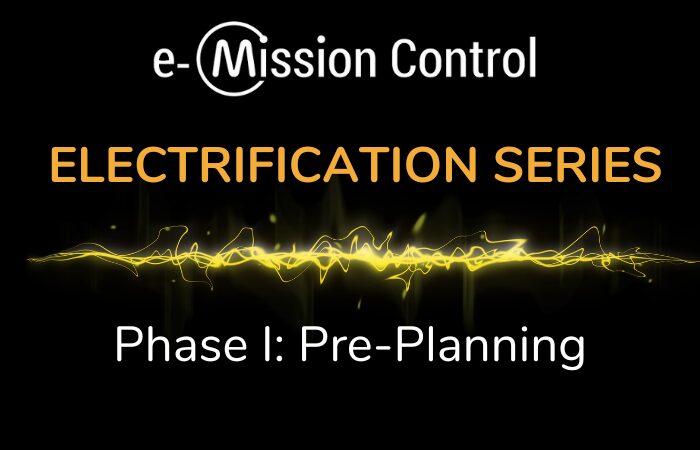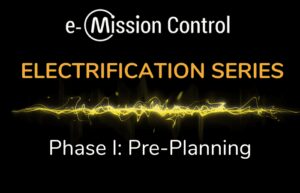

As a fleet owner or operator, you may be driven by state regulations or your own business practices to build a sustainable future. Electrification is a crucial aspect to consider for the next 24-36 months and electrification planning is the first step. However, the process of transitioning to electric vehicles may seem daunting, and it can be challenging to know where to begin.
At e-Mission Control, we have worked with numerous fleets in various states and understand the challenges companies face when electrifying their fleets. We have conducted research to develop a four-phase process for full electrification, which we will discuss in a series of blog posts. The four phases are:
This electrification pre-planning phase, which is critical to the success of the project, is estimated to take one to three months and has up to eight steps.
1. Start With your “Why” – As a company representative, you always have the best interests of your organization at heart. When implementing electric vehicles and equipment, understanding your motivations becomes even more critical to ensure the success of your efforts.
By identifying the reasons behind the decision to switch to electric vehicles, whether it be to reduce costs, increase efficiency, or improve sustainability, you can stay focused on the goals that matter most to your organization.
Keeping your “why” in mind throughout the electrification planning and implementation process reinforces your commitment to your company’s objectives, even when faced with obstacles and challenges. By staying true to your purpose, you can make informed decisions and lead your company towards a more sustainable future.
2. Involve Key Stakeholders and Get Buy-in from all Levels – When implementing a significant change like transitioning to electric vehicles and equipment, involving key stakeholders and getting buy-in from all levels of your organization is critical. Your employees, managers, and executives are essential stakeholders that must be informed and onboard with the process to achieve a successful outcome.
By involving key stakeholders from the beginning, you can gain valuable insights into the unique challenges and opportunities of each department or team. This information can inform the development of a comprehensive plan that accounts for the specific needs of each group, ensuring a smooth transition to electric vehicles.
Getting buy-in from all levels of your organization is equally important. You must create a shared vision of the benefits of transitioning to electric vehicles and equipment, and explain how the change will impact everyone involved. When employees feel valued and included in the process, they are more likely to embrace the change and be proactive in its implementation.
Involving key stakeholders and getting buy-in from all levels creates a sense of ownership and shared responsibility, leading to a successful transition that aligns with the company’s overall objectives.
3. Perform a Risk Tolerance Assessment – Performing a risk tolerance assessment is a crucial step in any transition, especially when moving to electric vehicles and equipment. When electrification planning, it’s important to identify potential risks and develop strategies to manage and mitigate them before implementing the change.
During a risk tolerance assessment, you should consider the potential risks associated with the new technology, such as compatibility with existing infrastructure, the availability of charging stations, and the impact on the supply chain. Identifying potential risks helps to prepare for any obstacles that may arise and develop strategies to manage them effectively.
By performing a risk tolerance assessment, you can establish a plan to mitigate risks and ensure the transition is as smooth as possible. This will allow you to make informed decisions and prioritize resources based on the level of risk associated with each potential issue. Ultimately, taking the time to perform a risk tolerance assessment will help you avoid potential pitfalls and set your organization up for a successful transition to electric vehicles and equipment.
This will guide decision making throughout the process of applying for grants and funding. Learn more about risk tolerance in relation to funding strategy in our Charge Cycle podcast with Matt Hart, CEO of Momentum. Momentum has successfully helped deploy more than $6 billion in funded projects in collaboration with more than 1,000 clients and partners.
4. Determine if you Want to Start with a Pilot – Starting with a pilot project is a great way to test the waters and identify potential issues before transitioning to electric vehicles and equipment fully, but it can delay your overall timeline for project deployment. It’s an opportunity to learn from experience and evaluate the impact of the change on your organization, without committing to a full-scale implementation. A pilot project can help you identify and address potential issues before scaling the change, ultimately leading to a more successful implementation, although at the cost of more aggressive decarbonization, and potentially, more cost savings overtime.
5. Determine if Charging-as-a-Service (or similar) is a Good Fit for You – Charging-as-a-service is an option that could make the transition to electric vehicles and equipment easier for your organization. It’s a subscription-based service that provides access to charging infrastructure, eliminating the need for you to invest in expensive charging stations. It’s important to determine if this service is available to you and whether it is a cost-effective solution for your organization.
Electrada, an e-Mission Control partner, handles everything organizations need to power their electric vehicles, including infrastructure, energy, capital, and performance. Depot charging may also be easier and lower-cost than installing your own chargers.
6. Determine Duty Cycles and Scope – Getting granular insight into your existing operations is key to understanding how you might apply an electric alternative. Not just where are your vehicles and/or equipment operating, but for how long, by whom, where are they stopping for longer periods, how hard are they being operated? What are their loads, idle times, miles driven per day? There is an endless amount of things to consider, but it will be worth the effort. That said, do not get stuck in analysis paralysis. Timeliness is still key.
7. Estimate Energy Needs – After completing the above in your electrification planning process, a small amount of math should get you to a level where you can estimate an equivalent kWh energy consumption for doing the same amount of work. Be sure to account for when electrical energy is being consumed, as the cost-benefit analysis can vary widely if the duty cycles conflict with time-of-use charges.
8. Facility Evaluation and Upgrade – One of the most important steps in implementing an electric vehicle fleet is evaluating the impact it will have on your facility. Work with your utility to model energy usage and avoid drawing unplanned power or overestimating consumption, which could increase infrastructure costs. Your local utility will help you ensure that high power demands won’t place undue stress on the existing electrical infrastructure. They’ll help evaluate the main service panel, transformers, wiring, and distribution equipment. By completing a grid evaluation, you can ensure your EV implementation is sustainable and won’t have a negative impact on the grid. Keep in mind there may be a waiting period to work with your utility, so plan early.
Whether your goal is to reduce emissions, save money, adhere to state law, or be a technical leader in your industry, deploying electric vehicles and equipment can help you achieve your goals and contribute to a more sustainable future.
Have you found this blog on electrification planning valuable? Stay tuned for electrification transition Phase 2: Developing a Timeline and Budget.